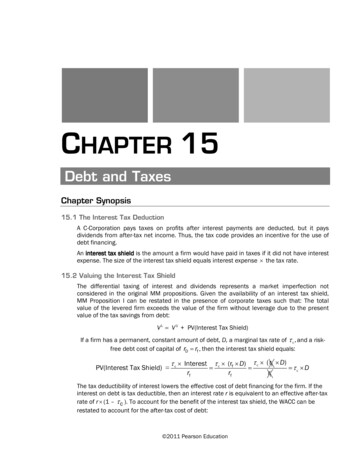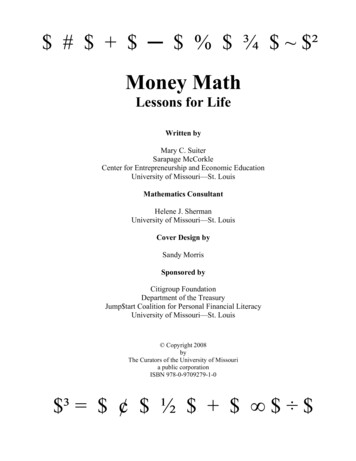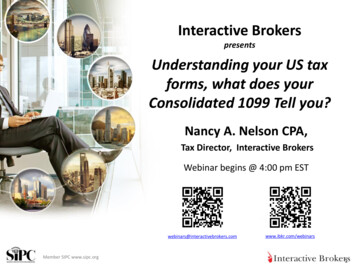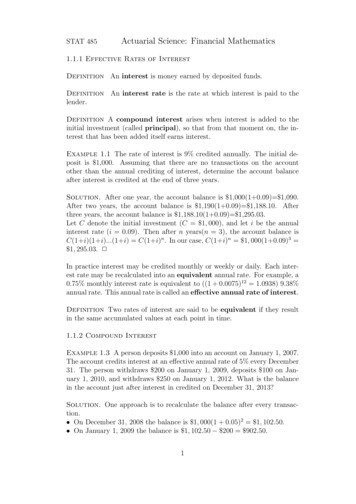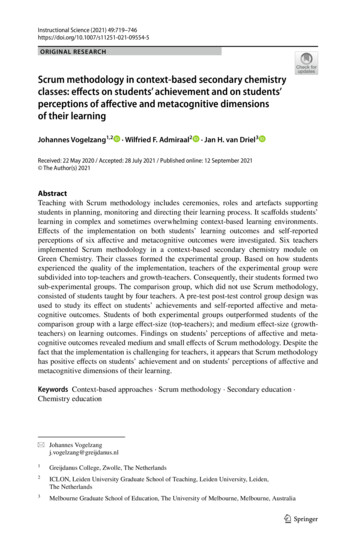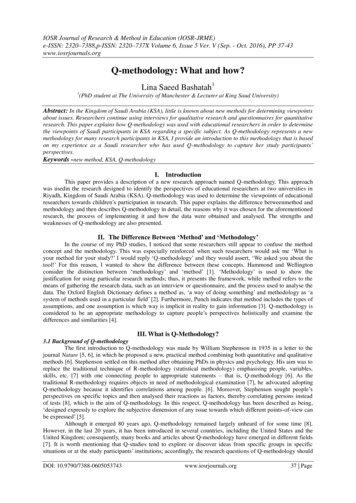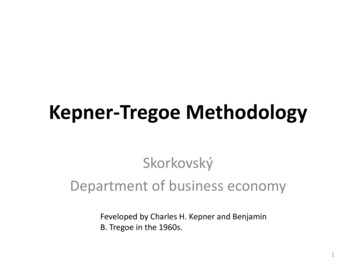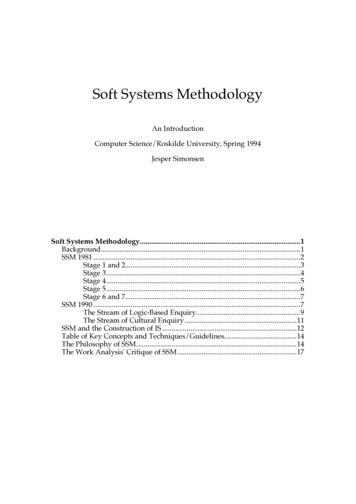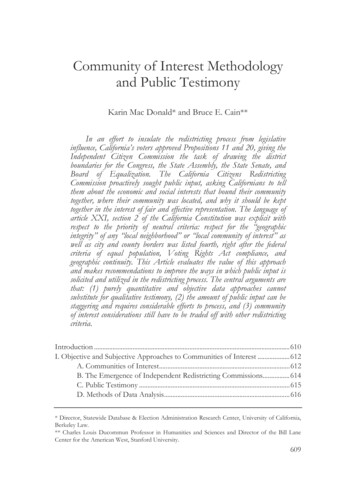
Transcription
Community of Interest Methodologyand Public TestimonyKarin Mac Donald* and Bruce E. Cain**In an effort to insulate the redistricting process from legislativeinfluence, California’s voters approved Propositions 11 and 20, giving theIndependent Citizen Commission the task of drawing the districtboundaries for the Congress, the State Assembly, the State Senate, andBoard of Equalization. The California Citizens RedistrictingCommission proactively sought public input, asking Californians to tellthem about the economic and social interests that bound their communitytogether, where their community was located, and why it should be kepttogether in the interest of fair and effective representation. The language ofarticle XXI, section 2 of the California Constitution was explicit withrespect to the priority of neutral criteria: respect for the “geographicintegrity” of any “local neighborhood” or “local community of interest” aswell as city and county borders was listed fourth, right after the federalcriteria of equal population, Voting Rights Act compliance, andgeographic continuity. This Article evaluates the value of this approachand makes recommendations to improve the ways in which public input issolicited and utilized in the redistricting process. The central arguments arethat: (1) purely quantitative and objective data approaches cannotsubstitute for qualitative testimony, (2) the amount of public input can bestaggering and requires considerable efforts to process, and (3) communityof interest considerations still have to be traded off with other redistrictingcriteria.Introduction . 610I. Objective and Subjective Approaches to Communities of Interest . 612A. Communities of Interest . 612B. The Emergence of Independent Redistricting Commissions. 614C. Public Testimony . 615D. Methods of Data Analysis . 616* Director, Statewide Database & Election Administration Research Center, University of California,Berkeley Law.** Charles Louis Ducommun Professor in Humanities and Sciences and Director of the Bill LaneCenter for the American West, Stanford University.609
610UC IRVINE LAW REVIEW[Vol. 3:609E. The American Community Survey Used as Redistricting Data . 619II. Establishing Communities of Interest Through Public Testimony . 623A. Where Testimony Mattered . 628B. The Compatibility of Communities of Interestand Other Formal Criteria . 633Conclusion . 635INTRODUCTIONThe novelties of any redistricting cycle can take many forms—shifts injudicial doctrine,1 evolving political conditions,2 technical refinements,3 orinstitutional innovations.4 Sometimes what seems new is actually old, onlyrepackaged or embedded in a different political or institutional context. In the2011 redistricting cycle, traditional formal criteria—such as respect for localcommunity boundaries, compactness, and community of interest considerations—gained new prominence as a consequence of two important institutionaldevelopments: the evolution of increasingly independent redistrictingcommissions (IRCs) and the expanding role of public testimony.The connection between these two developments and the new emphasis oncommunities of interest (COIs) and public testimony is not merely coincidental.1. Given the Supreme Court’s reputation for following precedent, it is remarkable that thevarious phases of modern American redistricting are more marked by sharp shifts in judicial doctrinethan any sudden change in political conditions. Court decisions have dictated the frequency ofredistricting, Baker v. Carr, 369 U.S. 186, 197–98 (1962), the permissible structure of statebicameralism, Reynolds v. Sims, 377 U.S. 533, 568 (1964), and the standards for determining racialdiscriminatory effects, Thornburg v. Gingles, 478 U.S. 30, 58–61 (1986). Sometimes the Court’sdecisions have cut off trends, as in the Shaw line of cases. Shaw v. Reno, 509 U.S. 630, 630–31 (1993)(holding that electoral redistricting based on race must pass strict scrutiny); see also Hunt v. Cromartie,526 U.S. 541, 541–42 (1999) (holding that there was insufficient evidence of racial motive behindNorth Carolina’s congressional redistricting plan for the district court to have granted summaryjudgment); Abrams v. Johnson, 521 U.S. 74 (1997) (finding that Georgia redistricting plan did notviolate the Equal Protection Clause); Bush v. Vera, 517 U.S. 952, 954–55 (1996) (holding that a Texasredistricting plan failed strict scrutiny); Shaw v. Hunt, 517 U.S. 899 (1996); Miller v. Johnson, 515 U.S.900, 900–02 (1995) (applying the Court’s holding in Shaw to find a redistricting policy in Georgiaunconstitutional). We covered the historical phases of redistricting trends in Bruce E. Cain, KarinMac Donald & Michael McDonald, From the Last Generation of Reform to the Next, in DEMOCRACY INTHE STATES: EXPERIMENTS IN ELECTION REFORM 199, 199–209 (Bruce E. Cain, Todd Donovan &Caroline Tolbert eds., 2008).2. Bipartisan gerrymanders were regarded more favorably in the less partisan 1970s than theyhave become in the current period of high polarization and frequent divided government. For anexample of how courts viewed gerrymandering in state legislative districts during the less partisan era,see Gaffney v. Cummings, 412 U.S. 735, 752–54 (1973).3. See Micah Altman, Karin Mac Donald & Michael McDonald, From Crayons to Computers: TheEvolution of Computer Use in Redistricting, 23 SOC. SCI. COMPUTER REV. 334, 335 (2005).4. See Bruce E. Cain, Redistricting Commissions: A Better Political Buffer?, 121 YALE L.J. 1808,1812–13 (2012) (analyzing the effectiveness of independent redistricting commissions as institutionalreform).
2013]COMMUNITY OF INTEREST METHODOLOGY611The central premise of the IRC model is that incumbent influence over theredrawing of district lines is an inherent conflict of interest that must beeliminated to the greatest degree possible in order to achieve a fair and neutralprocess.5 Given that a finite number of commission members cannot possiblyreflect all the nuanced, varied interests that arise in a large state redistricting, publicinput is critical to providing line-drawing guidance. In particular, the CaliforniaCitizens Redistricting Commission (CRC, or the Commission), took unprecedented steps to become publicly transparent and to solicit residents’ written andin-person testimony.6 While their efforts were largely well received, a few criticshave raised questions about the CRC approach. Some allege that the testimonythat the CRC heard was stacked by a coordinated political effort and biasedtowards liberal and Democratic interests.7 Others have argued that objectiveapproaches to determining community of interest should be given more play.8In the following sections of this Article, we will assess the role of publictestimony and COI approaches to make three points. First, purely quantitativemeasures of community of interest cannot supplant qualitative public testimony.Aside from the various problems associated with creating accurate measures andturning them into quantitative standards, public testimony gives a better snapshotof what matters to voters, residents, and communities at a given time and place. Ifthe goal is to reflect public interests and not merely to constrain line drawing insome seemingly neutral manner, public testimony is critical. Second, publictestimony can easily overwhelm the redistricting process and sometimes providesconflicting interpretations. A sincere and earnest effort to determine the public’sinterests in redistricting requires finding ways to process large amounts ofinformation rapidly, examining the feasibility of competing proposals, andmanaging public expectations about the ability to satisfy everyone’s demands.Lastly, community of interest considerations, however they are determined, mustbe traded off with other criteria. The more specific the ordering of criteria set outin state constitutions and laws, the easier the guidelines for commissioners tofollow.5. Id. at 1817–21.6. Id. at 1826–27.7. See Olga Pierce & Jeff Larson, How Democrats Fooled California’s Redistricting Commission,PROPUBLICA (Dec. 21, 2011), oled-californiasredistricting-commission.8. The foremost proponent of this is Nicholas Stephanopoulos, who has argued for objectivecommunity of interest standards in a trilogy of articles. See Nicholas O. Stephanopoulos, Communitiesand the California Commission, 23 STAN. L. & POL’Y REV. 281, 284–89 (2012) [hereinafterStephanopoulos, Communities and the California Commission]; Nicholas O. Stephanopoulos, Redistrictingand the Territorial Community, 160 U. PA. L. REV. 1379, 1385–86 (2012) [hereinafter Stephanopoulos,Redistricting and the Territorial Community]; Nicholas O. Stephanopoulos, Spatial Diversity, 125 HARV. L.REV. 1903, 1949 n.217 (2012).
612UC IRVINE LAW REVIEW[Vol. 3:609I. OBJECTIVE AND SUBJECTIVE APPROACHES TO COMMUNITIES OF INTERESTRedistricting standards fall into two basic types: (1) formal criteria focuseslargely on the shape, size, racial, and socioeconomic composition of the districtsand (2) fairness outcome measures such as proportionality and seats-votesymmetry.9 The case for formal criteria has always been made on two levels: theirintrinsic worth and their indirect value in constraining efforts to draw lines thatintentionally and unfairly favor one party or group over others. Some formalcriteria are easily measured and relatively uncontroversial—for example, thatdistrict boundaries must be contiguous (connected at all points) and have equalpopulations.10 By comparison, COI considerations—the expectation that districtsbe composed of “cognizable” common interests—are harder to identify a prioribecause there is a subjective component to the interests and boundaries of a givenCOI. The “interest” in a COI is not merely a clustering of some measurable socialor economic characteristic. Residents in that area have to perceive andacknowledge that a social, cultural, or economic interest is politically relevant. COIgeography is ultimately subjective as well. The boundaries of an interest“community” do not usually coincide neatly with government jurisdictions orfollow fixed, uniform patterns. Even advocates of better quantitative COImeasures concede that perception matters with respect to identifying COIs.11A. Communities of InterestThe idea that communities of interest matter in a good redistricting processis certainly not novel. COIs have been part of the mix in scholarly redistrictingdiscussions for decades.12 COIs are recognized in five state constitutions andseven other state statutes.13 COIs have also long been important in localgovernment redistricting.14 In California, COI was specifically mentioned in theMaster’s reports in 1973 and 1991:9. There was a vigorous debate over the merits of formal criteria in the 1980s. See, e.g., BruceE. Cain, Simple vs. Complex Criteria for Partisan Gerrymandering: A Comment on Niemi and Grofman, 33UCLA L. REV. 213, 214–16 (1985); Bernard Grofman, Criteria for Districting: A Social Science Perspective,33 UCLA L. REV. 77, 79–93 (1985); Daniel H. Lowenstein & Jonathan Steinberg, The Quest forLegislative Districting in the Public Interest: Elusive or Illusory?, 33 UCLA L. REV. 1, 12–35 (1985).10. Although there has been a vigorous debate over using adjusted versus unadjusted censusdata for several decades, the major population-related issue in the last two redistricting cycles centeredmore on whether to use VAP or CVAP numbers when accounting for minority populations underthe VRA. Nathaniel Persily, The Law of the Census: How to Count, What to Count, Whom to Count, andWhere to Count Them, 32 CARDOZO L. REV. 755, 778 (2011).11. Stephanopoulos acknowledges that territorial communities have a “third element, a feelingof communal affiliation” that is “subjective in nature.” Stephanopoulos, Redistricting and the TerritorialCommunity, supra note 8, at 1430.12. An early proponent of this approach was geographer Richard Morrill. See, e.g., Richard L.Morrill, Redistricting, Region and Representation, 6 POL. GEOGRAPHY Q. 241, 251–53 (1987).13. Stephanopoulos, Redistricting and the Territorial Community, supra note 8, at 1424–25.14. See Bruce E. Cain & David A. Hopkins, Mapmaking at the Grassroots: The Legal and PoliticalIssues of Local Redistricting, 1 ELECTION L.J. 515, 527–29 (2002).
2013]COMMUNITY OF INTEREST METHODOLOGY613[S]ocial and economic interests common to the population of an areawhich are probable subjects of legislative action . . . should be consideredin determining whether the area should be included within or excludedfrom a proposed district in order that all of the citizens of the districtmight be represented reasonably, fairly and effectively.15The Masters wording reveals very clearly that community of interest hasalways been a territorial concept (i.e., a defined area with certain commoneconomic, social, or cultural interests).16The rationale for COI-based districts derives implicitly from a delegate viewof representation. In the delegate conception, the representative’s job is toadvocate for the majority interests and preferences of constituents residing withinthe boundaries of a given district or territorial jurisdiction. In the trustee version,the representative makes a best judgment about a policy’s merits and in the virtualrepresentation model, the representative advocates for supra-territorial interestssuch as a political parties, classes, or organizations. District composition matterslittle for the trustee or virtual models, but potentially a great deal in the delegatecase. It is easier for representatives to advocate for constituents who have widelyshared attributes and a greater sense of kinship.On the voter side, COIs can facilitate grassroots electoral coordination andencourage higher levels of civic involvement and participation when they coincidewith local networks.17 Whatever the advantages of COI, it is important to realizethat it is linked to a particular form of democratic representation (i.e., therepresentative as delegate), not to a core democratic concept. For this reason, it ismore appropriately a matter for state regulation, not constitutional doctrine.Apart from its intrinsic merits, the community of interest approach alsoindirectly limits line drawers’ discretion to skew the lines in favor of particulargroups, incumbents, or parties. Limiting options to those with plausible COIrationale, some believe, is the best way to achieve a fair redistricting plan, or at15. Legislature v. Reinecke, 516 P.2d 6, 16 (Cal. 1973).16. In distinguishing his terminology of territorial community from COI, Stephanopoulosstates:I [prefer] the term “territorial community” instead of the more common “community ofinterest” because of certain connotations that the latter phrase has acquired. For one thing,a community of interest does not have to be spatially bounded, meaning that it coexistsuneasily with the American system of geographic districting. In addition, a community ofinterest can be deemed to arise on the basis of any common concern, making the termnotably imprecise and malleable. With its strong geographic valence and emphasis on thefull array of interests and affiliations that people share, the concept of a territorialcommunity seems substantially more determinate.Stephanopoulos, Redistricting and the Territorial Community, supra note 8, at 1431–32 (footnote omitted).The term Stephanopoulos uses, “territorial community,” really refers to the technique of factoranalyzing census and other data to determine COI clusters. As such, it is one specific way ofattempting to determine COI.17. See Stephanopoulos, Communities and the California Commission, supra note 8, at 288.
614UC IRVINE LAW REVIEW[Vol. 3:609least, one that minimizes bias significantly.18 In its dual functionality, COI is likeother formal criteria such as compactness and respect for city or county lines.Since any one of the formal criteria, including COI, can be manipulated undercertain circumstances for party or group benefit, the reform trend has been tolayer as many formal constraints on the process as possible. However, the moreredistricting criteria in play, the more important the trade-off between conflictingcriteria becomes. A sensible answer, adopted in California, is to provide a listing inorder of priority.19 It is unclear whether all the supporters of Propositions 11 and20 that created the CRC understood the implications of ordering criteria, as someCRC proponents who wanted more “electoral competition” were apparently laterdismayed at the attention paid to COI testimony.B. The Emergence of Independent Redistricting CommissionsWhile the COI concept is not novel, the emergence of independentredistricting commissions has given it more prominence. IRCs are the culminationof a reform effort aimed initially at reducing, and more recently at eliminating, theconflicts of interest that incumbent legislators have when drawing districtboundaries for themselves.20 Commissions vary in their degree of separation fromincumbent legislators and other political officials, but independent citizencommissions define the far end of the degree of separation continuum.21IRCs in general are primarily defined by what they are not—entitiescontrolled by incumbents and politicians—as opposed to what they are supposedto be. The ambiguity of their role gives rise to different possible interpretations.One interpretation is that citizen commissioners should act as neutral decisionmakers, much as the courts do when they are forced to devise plans as theredistricting agent of last resort. Courts and court masters do not take extensivetestimony or rely on public definitions of COI. This conception of the impartialarbiter suggests that the citizen commissioner adheres strictly to constitutional andstatutory guidelines and balances redistricting criteria trade-offs in a neutral,evenhanded fashion behind the judicial veil of above-the-fray legitimacy. Thelegitimacy of this approach hinges on all parties buying into the belief that legaland professional norms of impartiality will ultimately prevail. In practice, thelosers in judicially imposed redistricting plans often read bias into the finaloutcomes.2218. Morrill, supra note 12, at 248.19. See CAL. CONST. art. XXI, § 2(d)(1)–2(d)(6).20. Cain, supra note 4, at 1826–27.21. Id. at 1818, 1844.22. Nathaniel Persily notes:Rarely will everyone involved in redistricting litigation agree that a court-drawn plan is“fair.” By looking at the partisan data while constructing its plan, however, a court mightbe better able to avoid the accusation that its plan is severely biased (in its effects, if not itsintent) against one of the parties.
2013]COMMUNITY OF INTEREST METHODOLOGY615Another less frequently practiced variant of the impartiality model is theneutral tie breaker23—someone who judges between the merits of competingplans submitted to them or who takes public suggestions and transparently meldsthem into a finished map product.24 Here too perceptions matter and losers willtend to read partisan intent into unfavorable outcomes.The Arizona and California IRCs however are more amalgamations ratherthan exemplars of any one decision-making model. On the one hand,commissioners were vetted closely (especially in California) for conflict of interestproblems and excessive partisanship, but at the same time there was a consciouseffort to pick commissioners who reflected the state as a whole, implying arepresentation model as well. For example, the CRC structure balanced thenumbers of Democrats, Republicans, and Independents on the Commission andput in place voting rules that required bipartisan agreement. Some commissionadvocates hoped that the presence of independents would give the commissions aperception of more neutrality, at least between the two parties. While critics inboth Arizona25 and California26 questioned the partisan neutrality of theindependent members, for the most part, if not completely neutral, they formed acentrist bloc that straddled party lines.The public was encouraged in both California and Arizona to submit plansfor districts or even the entire state, but while the commissioners took publicsuggestions seriously, they developed their own ideas and plans. The effects ofsubmitted statewide plans were primarily indirect. The basic architecture wasdeveloped at the CRC and staff end, but other proposals framed the discussion ofwhat was possible, particularly submissions by the civil rights groups (due to thethreat of potential litigation). Most of the testimony the CRC received initiallywere comments about local COIs, and then later reactions to specific linesproposed and posted online for public viewing.C. Public TestimonyDetermining COI through public testimony can be expensive and raisesquestions about selectivity bias. The CRC set up meetings throughout the state tohear testimony on what people in different parts of the state thought were thegeographic communities that needed to be kept together (i.e., not divided by adistrict boundary) and which surrounding areas had the most common interests.27Nathaniel Persily, When Judges Carve Democracies: A Primer on Court-Drawn Redistricting Plans, 73 GEO.WASH. L. REV. 1131, 1164 (2005).23. This is the model used in New Jersey’s politician commission system. Mark J. Magyar,Redistricting Reform in New Jersey 1 (Friends of Local Gov’t Policy Paper Series Vol. 3 No.4, 2011),available at http://www.njlmef.org/policy-papers/FoLG v3 4 Magyar.pdf.24. Id.25. Cain, supra note 4, at 1831–32.26. Id. at 1826–27.27. Stephanopoulos, Communities and the California Commission, supra note 8, at 288–89.
616UC IRVINE LAW REVIEW[Vol. 3:609It is no small logistical matter to transport staff and commission members arounda large state, advertise widely, do outreach to groups and individuals who mightotherwise be under-represented, and then collect and post the material with ashort turnaround time. It is far cheaper to draw lines behind closed doors withminimal public input.A common criticism of public testimony is the danger of selectivity bias.Studies of public testimony generally suggest that the people who show up toobserve and testify at public hearings can be a biased sample of the totalpopulation.28 Inevitably, redistricting hearings attract some types of constituentsmore than others. It is a relatively technical subject that precludes many citizensfrom participating. Well-organized neighborhoods, civil rights lawyers, and localpolitical officials will have more knowledge and interest in the proceedings thanthe average citizen. Outreach and publicity can improve awareness, but, in theend, redistricting tends to appeal to the political hard core. It was alleged inCalifornia that the testimony was biased further by an organized attempt to recruitlocal activists and party officials to testify before the Commission.29Whether that was true, it is fair to say that commissioners have to weigh thesource of the information they receive as they evaluate the merits of a particularCOI claim.The objective position argues that COIs can best be determined by lookingfor clusters of census indicators or other data. The most prominent proponent ofthis view in recent years is Professor Nicholas Stephanopoulos who in a trilogy ofarticles proposes a territorial communities method:[E]lectoral districts should be required to correspond to underlyingterritorial communities. To the extent possible, the boundaries of districtsand organic geographic communities should be required to coincide—and the courts should be prepared to intervene when communities areunnecessarily fused, fragmented, or subverted, and the state can offer noreasonable explanation for the communal disruption.30The allure of an objective COI approach is clear. The time and money spenton gathering citizen testimony could be avoided if COIs can be determined bystatistical procedures. Is this hope realistic?D. Methods of Data AnalysisThe method of territorial community relies on a statistical procedure calledfactor analysis—a statistical algorithm that identifies clusters of data indicatorsthat are assumed to be generated by underlying unmeasured variables—in this28. See, for instance, Kevin M. Leyden, Interest Group Testimony and Resources at CongressionalHearings, 20 LEGIS. STUD. Q. 431, 435–37 (1995), for evidence that groups with resources tend toappear more often at public hearings.29. See Pierce & Larson, supra note 7.30. Stephanopoulos, Redistricting and the Territorial Community, supra note 8, at 1384–85.
2013]COMMUNITY OF INTEREST METHODOLOGY617case, territorial communities.31 For his study of California, ProfessorStephanopoulos uses both the Census Bureau’s American Community Survey(ACS) and a second data set of votes on statewide popular initiative measures.32With the ACS data, he found that “the factor with the greatest explanatory poweris a joint measure of socioeconomic status and Hispanic ethnicity” thatdistinguished tracts of “wealthy, well-educated, white professionals” from tractswith “poorer, less educated Hispanics working in blue-collar fields.”33 The otherfactors, in order, were marital status, race, sprawl, and age.34 With the initiativedata, the factors he discovered were fiscal policy preferences, socio-cultural issues,and Native American gaming. Stephanopoulos defines his measure of districthomogeneity as the standard deviation of the census tracts’ scores weighted by thevariance explained by each factor.35The basic intuition of this territorial communities approach can be describedsimply. COIs are clusters of objective indicators. Good districts are composed ofsimilar census tracts as identified by the factor measures (i.e., deviate the least intheir scores). The greater the homogeneity of various tracts in a district, the betterthe redistricting design. The territorial community vision of representation is firstorder homogeneity offset by second-order heterogeneity: demographically similarpeople are grouped together into districts but with wide variation across districtsin the types of interests represented.36 In general, there is nothing wrong with thisview of representation. However, the relevant question is not its legitimacy butwhether it should be mandated as the baseline standard by state or federal courts.In terms of its inherent merits, homogeneous districts are not clearlysuperior or intrinsically more democratic than heterogeneous districts. Indeed thisquestion parallels the issues of perspective in the at large versus single memberdistrict system debate. The U.S. Progressive movement in the early twentiethcentury moved to at large districts to weaken neighborhood parochialism andmachine politics and to incentivize a jurisdiction wide perspective. Mandating oreven legally prioritizing homogeneous districts would preclude any future effortsto balance parochial area with jurisdiction-wide perspectives. Proponents of morecompetition in U.S. politics would also lose a potential tool. While competitiveseats can be socioeconomically homogeneous, it is more common to make a seatcompetitive by blending different types of constituents. If a territorial communityapproach were adopted as a judicial standard, it would preclude other equally validapproaches to electoral design.31. See HARRY H. HARMAN, MODERN FACTOR ANALYSIS 3–6 (3d rev. ed. 1976).32. Stephanopoulos, Communities and the California Commission, supra note 8, at 289–90. Thisviolates the CRC pledge to ignore political data. Pierce & Larson, supra note 7.33. Stephanopoulos, Communities and the California Commission, supra note 8, at 291.34. Id. at 290.35. Id. at 291.36. Id. at 283, 289–93.
618UC IRVINE LAW REVIEW[Vol. 3:609In addition, just because people share census attributes does not mean theyperceive political commonality. Political agendas can shift rapidly betweenelections or slowly over time from economic issues to social issues: being ahomeowner might be more important in one election, but being a Catholic maymatter in another. Census data are not collected for the purpose of trackingcurrent policy concerns. Imputing political importance to variables chosen for thepurpose of demographic accounting can be misleading, which is perhaps whyStephanopoulos experimented with his initiative data.37 Still, there is no escapingthe selection bias problem. The initiative data set is likely skewed towards issuesthat could not be resolved in the legislature or that were able to attract enoughresources to qualify for the ballot. Implying political identity from objective data isproblematic unless the real goal is not better representation per se but to preventgerrymandering.So perhaps the real purpose is gerrymander prevention. That is to say, thereal justification of this approach might be to lock in a district buildingmethodology that makes intentional bias more difficult. But is the territorialcommunity method easier to use, less vulnerable to potential manipulation andmore likely to produce “fair results”? Stephanopoulos cites evidence that suggeststhis might be so, but since none of these studies used his territorial communitymethod and traditional COI criteria are often used in conjunction with otherformal criteria, it is
612 UC IRVINE LAW REVIEW [Vol. 3:609 . Master's reports in 1973 and 1991: 9. There was a vigorous debate over the merits of formal criteria in the 1980s. . more on whether to use VAP or CVAP numbers when accounting for minority populations under the VRA. Nathaniel Persily, The Law of the Census: How to Count, What to Count, Whom to Count, and
